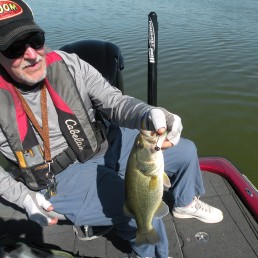A Proven Winner for Deep or Shallow Bass
SHARE THIS POST
Several years ago, Gene Larew Lures came out with what’s become known as the Swing Jig, and it quickly won a big-league bass tournament. Swing jigs are built with a Z-bend, wide gap hook that moves independently on a wire behind the head. It “swings” loosely as the bait moves. A plastic trailer is rigged weedless to avoid snags.
I started using it to catch largemouth in place of a regular football head jig on a spring trip to Kentucky Lake. It worked well.
When I got home, I bought the mold so I could make my own in sizes from 1/2- to 1 1/4-ounce.
My real breakthrough, though, came one fall day when we had friends up to chase river smallmouth. We used two boats. Both of us wanted to fish a certain stretch of river. We had previously done well on it, and I could tell that my friend Don really, really wanted first crack at it. So, I acquiesced, and let him blow down the river with his 250 throwing up quite the rooster tail.
My boat mate Dennis and I just kind of sat there idling, watching the show as Don’s boat got smaller, roaring down the river.
“Well,” Dennis said, “where should we go?”
I thought about it, and countered, “Let’s fish behind him. I have an idea.”
We gave Don some time to start working the area in question. We took a slow ride downriver and pulled in about half a city block behind them.
Dennis took out the flukes and tubes we had been using. I thought it might be time to test the swing jig on home waters. I left my regular weapons on the deck and tied a half-ouncer to a little heavier rod armed with 14-pound fluorocarbon.
Dennis didn’t do quite as well on the shallow cover that was already worked over. But I was well pleased. I ended up with five nice smallies. I Just reeled the swing jig/creature plastic combo slowly over the tops of the rocky cover where the bank met the substrate.
What clinched the deal was the retrieve, not allowing the heavier jig to wedge in among the 1.5 million rocks covering the river bottom. The bass just caught up to it and sucked it in. They also weren’t pressured, like the fish roaming the upper area of the riprap banks.
Are you enjoying this post?
You can be among the first to get the latest info on where to go, what to use and how to use it!
I have fished a lot of tubes, flukes, centipedes and other smaller plastics over the years, losing my share of jigs to the jaws of bottom while trying to get my baits in front of reactionary bass. Fishing slow and heavy on rocky rivers is usually akin to being cursed by a voodoo elder. You can spend all day tying on new baits if you let them settle in the crevices.
At the time, I used the 1/2-ounce swing jig on deeper water. But, having gone as light as 1/8-ounce on other offerings, I was more than pleased to know that Do-it Molds (do-itmolds.com) also has a smaller-sized swing jig mold available. It starts with 1/8-ounce and moves heavier, from 3/16-, 1/4-, 5/16-, 3/8- and 7/16-ounce sizes.
With this spread, you can run a light swing jig up on top of rocky riffles for smallmouths and even along inside weed edges and pencil reed beds for largemouths. Quite shallow water, usually.
If you have all sizes, it’s akin to having a bag full of golf clubs. Just set one up that works for the situation.
Fishing it is pretty simple. Just cast it out, let it sink and move it back so it doesn’t wedge into crevices. Or, as one of my fishing friends voiced. “Pay attention. And just keep the damn thing in contact with the bottom.”
As an example, we fished a late-summer area with weeds in three feet of water. The weeds gave way to a rock bar which dropped into 8 feet of water. When we got there, we stayed deep and tossed up on the rock. No takers. My friend frowned, “They were all over the rock yesterday.”
One of the nice things about the swing jig is that you can get some major casting distance on it with the heavier head (that you then need to keep out of the snags). And it’s weedless, too.
I remember that day. I really launched one after several casts were shunned. I watched it pass over the bar and into the weeds. As it broke through the weed edge, I thought I felt a slight bump, but attributed it to the different bottom after coming out of the weeds. In retrospect, I wasn’t sure, so I launched another one, and started reeling—then feeling the same sensation. This time, I reacted. And a good smallmouth came flying out of the water. When we boated it, the fish was spitting up lunch: perch about six inches long. Which was in the weeds. The bass had simply moved farther up.
Get better results from the time you spend fishing. Use information from the pros found in every issue of MidWest Outdoors, available by subscribing on our website.
MWO
SHARE THIS POST
You may also like...
Nothing found.
Did you enjoy this post?
You can be among the first to get the latest info on where to go, what to use and how to use it!
Tom Luba
Tom Luba is a freelance outdoor writer living in New London, Wis. He has written about open water fishing for more than 35 years.
